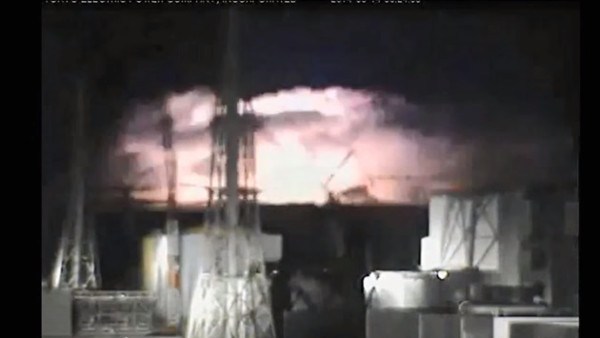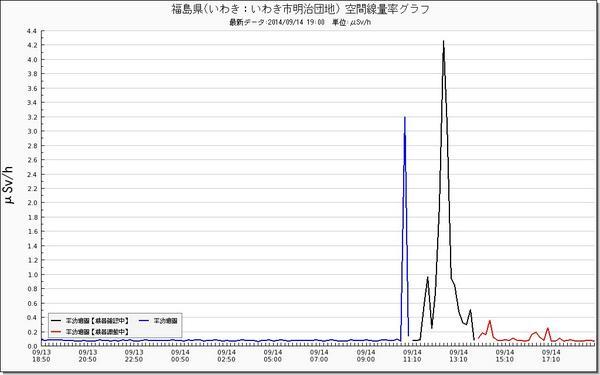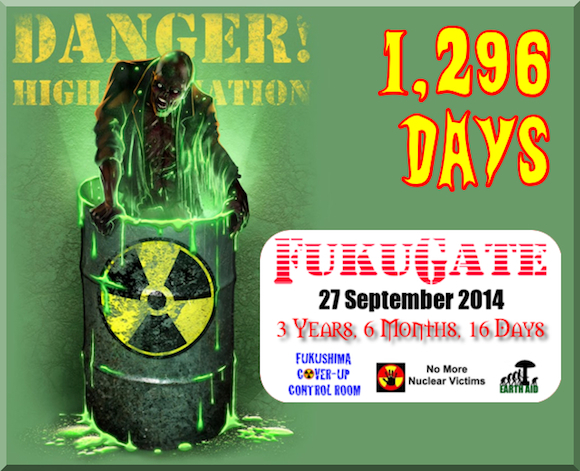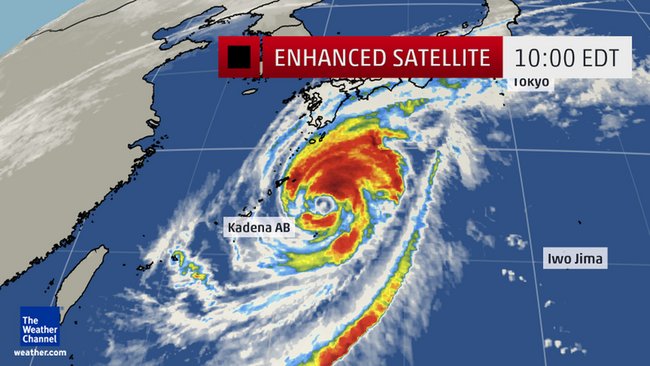It looks like you're using an Ad Blocker.
Please white-list or disable AboveTopSecret.com in your ad-blocking tool.
Thank you.
Some features of ATS will be disabled while you continue to use an ad-blocker.
share:
a reply to: neo668
I've read that cancers from nuclear waste can take 10 years to show up (of course depending on amount and type of exposure). Even though cancer rates are ridiculously high today there is never any talk or thought to the cause other than "environmental" or from "smoking". Technically radiation becomes "environmental" but radiation as a direct cause of cancer isn't talked about despite all the data showing direct links. I'm led to presume this is because the all powerful nuclear industry wields its might far and wide to anyone who dares to speak up about it.
I personally predict cancer rates to go up even higher with little or no reference/connection to Fukushima's part in North America (prevailing winds from Japan travel directly above us). It's not "just" Fukushima, there are lots of 'smaller' (but nonetheless potentially lethal) leaks from other plants on top of all the (ridiculous) nuclear testing that went on decades ago.
I too eat very little fish anymore though I don't know if there's much point in avoiding it - as I understand hot particles it is more dangerous to breathe them in than eat them? And I'm pretty sure we've been layered with hot particles here at least from the initial blow-ups, I don't know if those are also released on an ongoing basis.
Do you have any information or insights about liquefaction from that earthquake? How concerned are the people there about Fukushima's radiation especially going into the ocean?
I've read that cancers from nuclear waste can take 10 years to show up (of course depending on amount and type of exposure). Even though cancer rates are ridiculously high today there is never any talk or thought to the cause other than "environmental" or from "smoking". Technically radiation becomes "environmental" but radiation as a direct cause of cancer isn't talked about despite all the data showing direct links. I'm led to presume this is because the all powerful nuclear industry wields its might far and wide to anyone who dares to speak up about it.
I personally predict cancer rates to go up even higher with little or no reference/connection to Fukushima's part in North America (prevailing winds from Japan travel directly above us). It's not "just" Fukushima, there are lots of 'smaller' (but nonetheless potentially lethal) leaks from other plants on top of all the (ridiculous) nuclear testing that went on decades ago.
I too eat very little fish anymore though I don't know if there's much point in avoiding it - as I understand hot particles it is more dangerous to breathe them in than eat them? And I'm pretty sure we've been layered with hot particles here at least from the initial blow-ups, I don't know if those are also released on an ongoing basis.
Do you have any information or insights about liquefaction from that earthquake? How concerned are the people there about Fukushima's radiation especially going into the ocean?
Take a Gander...
At the readings for Groundwater observation hole No.1-2:
www.tepco.co.jp...
Some extraordinary numbers for Sr-90. Decay heat.
- Purple Chive
At the readings for Groundwater observation hole No.1-2:
www.tepco.co.jp...
Some extraordinary numbers for Sr-90. Decay heat.
- Purple Chive
Unit 3 RPV Temp Activity
VESSEL BOTTOM HEAD(TE-2-3-69L1) temp started to jump around on September 7.
www.tepco.co.jp...
www.tepco.co.jp...
This measuring point had very steady temp readings for months.
- Purple Chive
VESSEL BOTTOM HEAD(TE-2-3-69L1) temp started to jump around on September 7.
www.tepco.co.jp...
www.tepco.co.jp...
This measuring point had very steady temp readings for months.
- Purple Chive
originally posted by: GaryN
a reply to: wishes
...all the data showing direct links.
References?
??? Direct links to radiation exposure causing cancer??? It's common knowledge and a well proven fact. The problem with it is back-tracking cases of cancer to it's source. People (children) in Japan coming down with thyroid cancer after Fukushima who happened to live in its proximity is always chalked up as "coincidence". I don't know of anyone with cancer these days (I'm in Canada) whose doctor says oh you live up the prevailing winds from "x" or beside the nuke facility "x" so that's where you got it from. Doesn't happen that way.
There is ample proof that radiation exposure causes cancer - is just that attributing cancer outbreaks to radiation is taboo. So another 7+ years when there's all these new cancers around, it will never be thought of as coming from Fukushima (or other radiation sources), it will just be chalked up to "environment" as a cause.
Previously posted in this thread and not too far back are statements made from some doctors in Japan about the alarmingly high rate of thyroid problems in children in direct proximity of Fukushima. Can it be proven there is a "direct link" - not likely because the nuke industry aggressively stops all references to radiation causing cancer and all scientists rely on funding and are therefore vulnerable to being controlled.
edit on 19-9-2014 by wishes because: (no reason given)
a reply to: Purplechive
I have no understanding of the numbers and their implications - do you have any speculation what these mean? :-)
I have no understanding of the numbers and their implications - do you have any speculation what these mean? :-)
a reply to: wishes
Bad temp gauge? Corium movement? Not sure.
However, interesting after I posted...the temp stopped fluctuating...
www.tepco.co.jp...
- Purple Chive
Bad temp gauge? Corium movement? Not sure.
However, interesting after I posted...the temp stopped fluctuating...
www.tepco.co.jp...
- Purple Chive
a reply to: Purplechive
I posted this in the Fukushima by Numbers thread - I think it has a good collection of information - is a blog site but they talk a lot about studies with links. I found this segment most interesting about strontium spiking after 1000 days according to a German study - it also talks about the Daiichi plant being built on a diverted river bed causing its liquefaction. Am interested in what others think about this.
robinwestenra.blogspot.ca...
I posted this in the Fukushima by Numbers thread - I think it has a good collection of information - is a blog site but they talk a lot about studies with links. I found this segment most interesting about strontium spiking after 1000 days according to a German study - it also talks about the Daiichi plant being built on a diverted river bed causing its liquefaction. Am interested in what others think about this.
What we need is a model that predicts trends in strontium contamination under the conditions found at the Daiichi site. First, what conditions are found at Daiichi? TEPCO admitted in May of 2011 that core melt-throughs had occurred at the Daiichi site. Melted fuel has breached containment and is in direct contact with water at the site. The Daiichi site is very, very wet because it was built on the site of an old river bed, which was diverted for construction. The river has returned to its historical course under the Daiichi site. This explains why site liquefaction is occurring at the Daiichi site. So, we need a model of strontium contamination based on a water-logged melt-through scenario.
Enenews reported on a German study that roughly uses these parameters, although the German model was less water-saturated Study finds giant strontium-90 release into body of water begins around 1,000 days after reactor meltdown — 1,000 days after 3/11 = December 2013 — Graphic shows very high levels discharged for tens of thousands of days enenews.com... r-311-graphic-shows-very-high-levels-being-discharged-for-u The German simulation found that strontium-90 levels in ground water would likely spike dramatically 1,000 days after a meltdown. The study was published in the 1990s but has relevance for Fukushima’s melt-throughs. I read the article and this passage stood out: The highest radionuclide concentration of approx. 10 to the tenth power Bq/m3 is reached by Sr-90 after 5000 days. The effective equivalent dose for an adult is above 10 the second power Sv/a. After a prolonged period of about 10,000 days, Cs-137 reaches a maximum of about 10 to the eight power Bq/m3. The effective equivalent dose for this radioncuclide is approximately 1 sv/a.
A. Bayer, W. Tromm, & I. Al-Omari. Dispersion of Radionuclides and Radiation Exposure After Leaching by Groundwater of a Solidified Core-Concrete Melt. www.irpa.net... Majia here: This study may lend insight into TEPCO data on spiking strontium contamination. The study’s model best fits the data on spiking contamination levels, providing more conceptual and empirical evidence that at least one of the units at Fukushima Daiichi experienced full melt-through, known in popular jargon as ‘China Syndrome.’The Pacific Ocean is going to be hammered with Strontium-90 for years and years. The Enenews article noted that Ken Buesseler expressed concerns about bioacccumulation of strontium: enenews.com... r-311-graphic-shows-very-high-levels-being-discharged-for-u
Majia here: Hideo Yamazaki, a marine biologist at Kinki University, believes the site will continue to contaminate the ocean for years until massive structural repairs are made: ‘The current levels of contamination in the fish and seafood from the Fukushima coast will continue for a while, perhaps more than 10 years, judging from the progress in the cleanup process’. Marine animals at the top of the food chain and birds that feed on marine life will become highly contaminated under these conditions. Bioaccumulation and biomagnification are inevitable and I believe they will be devastating to Pacific life.
Bioaccumulation of cesium has been studied more widely than strontium because the former is easier to detect. In August of 2012, Jiji Press reported that ‘25,800 Becquerels of Cesium Detected in Fish Caught off Fukushima.’[ii] In March 2013, a fish measuring 740,000 Bq/kg was caught off of Fukushima.[iii] In April 2012 the Japanese media reported: ‘Cesium up to 100 times levels before disaster found in plankton far off nuke plant.’[iv] More recently: Fish with very high levels of cesium found near Fukushima January 11, 2014 ajw.asahi.com... A fish contaminated with extremely high levels of radiation was found in waters near the crippled Fukushima No. 1 nuclear power plant…The Fisheries Research Agency said Jan. 10 the black sea bream had 12,400 becquerels per kilogram of radioactive cesium, 124 times the safety standards for foodstuffs. The fish was caught at the mouth of the Niidagawa river in Iwaki, Fukushima Prefecture, on Nov. 17. The site is 37 kilometers south of the stricken power plant….The research institute said it will study the fish further to try and determine when it became contaminated with such high levels of radioactive cesium. Strontium contamination is ultimately going to be far more concentrated than cesium contamination. However, unless scientists go out and actually sample sea life across time they will not be able to predict cumulative strontium contamination levels.
Unfortunately, strontium is more difficult to test for than cesium. Scientists might well test only for cesium and then excluded all radionuclides as causing undiagnosed disease syndromes in sardines and starfish, for example, based on strontium-cesium ratios predicted in research studies such as the one examined above by Casacuberta, et al (2013).
robinwestenra.blogspot.ca...
Zworld and Aircooled....
Vindicated:
The glowing "Candy Canes":
From the inception of this thread, what so many folks had already surmised...
enenews.com... -about-plutonium-speculation-about-other-fuel-video
enenews.com... -explosion-black-smoke-possibly-burning-mox-uranium-fuel-photos
Grateful to ya all!!
- Purple Chive
Vindicated:
The glowing "Candy Canes":
Fragments or particles of nuclear fuel from the spent fuel pools above the reactors were blown “up to one mile from the units” and pieces of highly radioactive material reportedly fell between two units and had to be “bulldozed over,” to protect workers
From the inception of this thread, what so many folks had already surmised...
enenews.com... -about-plutonium-speculation-about-other-fuel-video
enenews.com... -explosion-black-smoke-possibly-burning-mox-uranium-fuel-photos
Grateful to ya all!!
- Purple Chive
Mystery explosion on Sept. 14 at Fukushima? Any ideas on what this is? Anode ray?


source
The news leaking out of Fukushima is also disturbing with Tepco now giving up on the ice wall and saying they will fill trenches with concrete which will unfortunately force up highly radioactive water.
We have also had two M5 earthquakes that occured in one hour and Fukushima Diary is reporting
Disturbing trends...


And extra info from Asyura2.com – English translation
“(It has) become a hot topic pink emission of mystery has seen in the 14 September at the Fukushima Daiichi nuclear power plant in Fukushima Prefecture.“
source
The news leaking out of Fukushima is also disturbing with Tepco now giving up on the ice wall and saying they will fill trenches with concrete which will unfortunately force up highly radioactive water.
We have also had two M5 earthquakes that occured in one hour and Fukushima Diary is reporting
60% of surveyed area in 2013 had land subsidence in Chiba prefecture.
It was 2040 km2, which is nearly as double as 2012.
Disturbing trends...
edit on 26-9-2014 by DancedWithWolves because: (no reason given)
a reply to: DancedWithWolves
Unit 3 had a RPV blip at this time.
www.tepco.co.jp...
www.tepco.co.jp...
Looks like lighting?? But with Fuku you never know!!
- Purple Chive
Unit 3 had a RPV blip at this time.
www.tepco.co.jp...
www.tepco.co.jp...
Looks like lighting?? But with Fuku you never know!!
- Purple Chive
originally posted by: DancedWithWolves
(Super)Typhoon Phanfone Heads Towards Japan This Weekend
Source
That should make for an interesting Japanese Grand Prix tomorrow afternoon.
originally posted by: Psynic
originally posted by: DancedWithWolves
(Super)Typhoon Phanfone Heads Towards Japan This Weekend
Source
That should make for an interesting Japanese Grand Prix tomorrow afternoon.
My apologies for a mostly off-topic post.
The extreme wet conditions at Suzuka Japan for the F1 have resulted in French driver, Jules Bianchi, losing control and crashing into a tractor which was on the track apron removing another crashed car.
He suffered severe head injuries and has been operated on in Mie Hospital.
This was not the kind of "interesting" I was counting on.
Millions of F1 fans are wishing and praying for Jules' recovery.
a reply to: DancedWithWolves
Unit 3...All Temps Drop...One Significantly
www.tepco.co.jp...
www.tepco.co.jp...
And TEPCO states rainwater pouring into Unit 3 Reactor building...
www3.nhk.or.jp...
- Purple Chive
Unit 3...All Temps Drop...One Significantly
www.tepco.co.jp...
www.tepco.co.jp...
And TEPCO states rainwater pouring into Unit 3 Reactor building...
www3.nhk.or.jp...
- Purple Chive
More good news from Fukushima...
fukushima-diary.com...
Gotta love that last two lines (bolding is mine) - they haven't taken any fundamental countermeasures against the next potential typhoon... how can anyone believe this fiasco is anything but intentional when virtually NOTHING is done to prevent as much damage as possible to the ocean, the fresh water, the air, the next earthquake, the next tsunami, the next typhoon. Yes, in government we trust (sarcasm in case it wasn't obvious ;-)
fukushima-diary.com...
At least 4 nuclides density became the highest in groundwater according to Tepco. The groundwater was taken from the sea side of Reactor 2, where Tepco is trying to construct underground frozen wall nearby. The sample was collected on 10/9/2014. It’s Cs-134/137, Co-60 and all β nuclide that became the highest level.
Cs-134 : 17,000,000 Bq/m3
Cs-137 : 51,000,000 Bq/m3
Co-60 : 2,100,000 Bq/m3
All β : 2,100,000,000 Bq/m3
Especially Co-60 density became 2.5 times much as the previous highest reading measured on 9/29/2014.
Tepco has nearly 10 borings around this well on the sea side of Reactor 2 , but they haven’t announced the analysis result of other borings.
Also, all β nuclide density in groundwater taken from the mountain side jumped up. The last reading on 10/3/2014 was 670,000 Bq/m3 but it marked 14,000,000 Bq/m3 on 10/8/2014. The previous highest reading was 8,300,000 Bq/m3 measured on 2/28/2014.
About all of these increases in radioactive density, Tepco states they assume it was caused by the rainfall of the typhoon. However, they haven’t taken any fundamental countermeasures against the next potential typhoon.
Gotta love that last two lines (bolding is mine) - they haven't taken any fundamental countermeasures against the next potential typhoon... how can anyone believe this fiasco is anything but intentional when virtually NOTHING is done to prevent as much damage as possible to the ocean, the fresh water, the air, the next earthquake, the next tsunami, the next typhoon. Yes, in government we trust (sarcasm in case it wasn't obvious ;-)
Typhoon Vongfong heads toward Japan and is the biggest this season and one of the biggest on records.
This will occur just one week after the last typhoon hit Japan.
The difference is that this one is expected to strike Japan and just about run up its center.
Hold tight, perhaps the Typhoon will be nice and empty out all the stored water.
I can just imagine Tepco's response "The Typhoon did it. We were ready for any normal Typhoon but this one was just too big. Not our fault."
We will know soon enough
P
This will occur just one week after the last typhoon hit Japan.
The difference is that this one is expected to strike Japan and just about run up its center.
Hold tight, perhaps the Typhoon will be nice and empty out all the stored water.
I can just imagine Tepco's response "The Typhoon did it. We were ready for any normal Typhoon but this one was just too big. Not our fault."
We will know soon enough
P
a reply to: pheonix358
Yes, the lack of accountability by Tepco and Japan government is appalling - the only thing that makes it pale by comparison is the lack of outcry and action from the 'rest' of the world... But what can be expected, most people don't even know a third tower went down in 9-11... *sigh*
to all contributors both past and present!!! MUCH appreciated!
Yes, the lack of accountability by Tepco and Japan government is appalling - the only thing that makes it pale by comparison is the lack of outcry and action from the 'rest' of the world... But what can be expected, most people don't even know a third tower went down in 9-11... *sigh*
to all contributors both past and present!!! MUCH appreciated!
new topics
-
Green Grapes
General Chit Chat: 3 hours ago -
Those Great Fresh Pet Commercials
Television: 8 hours ago -
S.C. Jack Smith's Final Report Says Trump Leads a Major Conspiratorial Criminal Organization!.
Political Conspiracies: 10 hours ago -
Advice for any young Adult .
General Chit Chat: 11 hours ago
top topics
-
Joe meant what he said about Hunter's pardon....
US Political Madness: 12 hours ago, 11 flags -
S.C. Jack Smith's Final Report Says Trump Leads a Major Conspiratorial Criminal Organization!.
Political Conspiracies: 10 hours ago, 11 flags -
Steering the Titantic from the Drydock.
Rant: 17 hours ago, 10 flags -
Advice for any young Adult .
General Chit Chat: 11 hours ago, 10 flags -
Green Grapes
General Chit Chat: 3 hours ago, 5 flags -
It’s Falling…
Philosophy and Metaphysics: 14 hours ago, 4 flags -
Regent Street in #London has been evacuated due to a “bomb threat.”
Other Current Events: 12 hours ago, 3 flags -
Those Great Fresh Pet Commercials
Television: 8 hours ago, 3 flags
active topics
-
Los Angeles brush fires latest: 2 blazes threaten structures, prompt evacuations
Mainstream News • 105 • : Mantiss2021 -
Steering the Titantic from the Drydock.
Rant • 43 • : charlest2 -
House Passes Laken Riley Act
Mainstream News • 21 • : WeMustCare -
What Comes After January 20th
Mainstream News • 33 • : underpass61 -
President Carter has passed
Mainstream News • 44 • : WeMustCare -
Those stupid GRAVITE commercials
Rant • 13 • : GENERAL EYES -
-@TH3WH17ERABB17- -Q- ---TIME TO SHOW THE WORLD--- -Part- --44--
Dissecting Disinformation • 3973 • : duncanagain -
Green Grapes
General Chit Chat • 1 • : nugget1 -
Those Great Fresh Pet Commercials
Television • 4 • : BingoMcGoof -
My personal experiences and understanding of orbs
Aliens and UFOs • 39 • : Compendium


